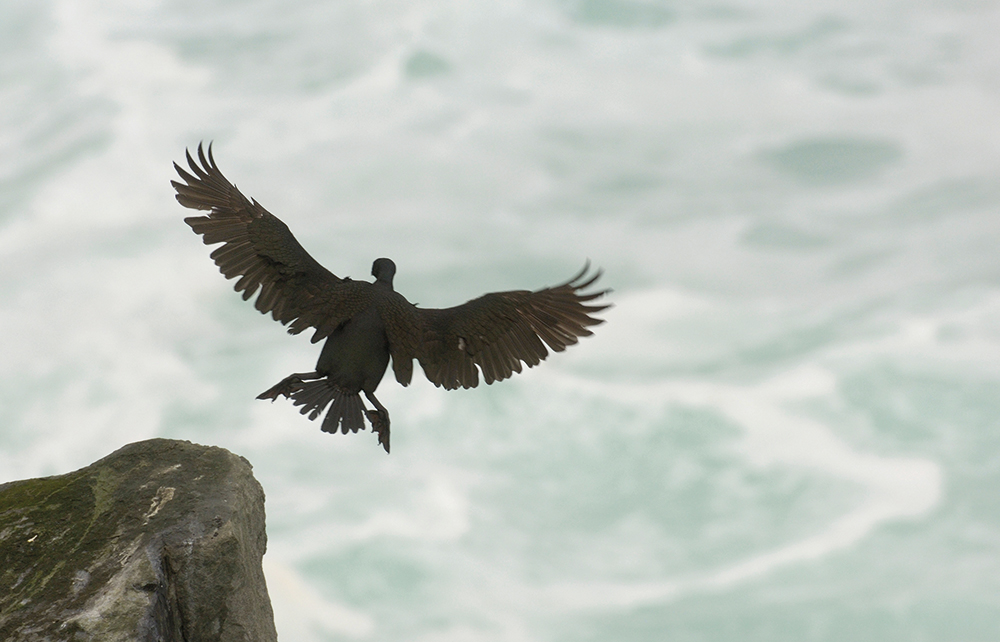Shetland comprises an archipelago of some 300 islands and skerries situated roughly half way between London and the Arctic Circle. Stereotyped by many outsiders as bleak and somehow ‘on the edge’, according to the poet Jen Hadfield’s stylish memoir – about her 17 years of living there – it can be more illuminating to see these places as somehow central to everything.
Visiting Foula, Hadfield overcomes her vertigo, finding the island ‘peaceful and dreadful’ all at once
Storm Pegs is as much an account of the author finding new personal bearings as a series of magic lantern slides about insular life. The title alludes to a traditional piece of perforated wood used by mariners to keep track of their whereabouts: you stuck the peg in a hole and navigated accordingly. The subtitle stresses that she is an incomer (a sooth-moother). She arrived in her twenties for a literary festival, and now dwells in a precarious caravan, mentally mapping her position in the busy flow of the world.
The story – in 32 loosely seasonal chapters – opens on a turbulent January day when Hadfield is violently seasick aboard the ferry crossing from Orkney. For someone leery of the sea, fearful of depths and heights (to say nothing of gales, drinkers and dogs), making a home on West Burra might not seem like the obvious option. It is a hardscrabble new life – ‘I look quite a lot like Worzel Gummidge,’ she writes, as she forages for whelks or spoots (razor-clams). But for all the setbacks and winter ‘darknesses’, she manages to make it intriguing (though I still cannot share her enthusiasm for folk festivals or Icelandic stockfish).
There are some wonderful, cannily observed set pieces: a skyfall shower of small fishes; the hunt for a rare tuber (roseroot, used by Sherpas to lend stamina at altitudes); the honing of a scythe; a night-time swim/dance in the bioluminescent surf (da mareel); and even her spell in a marine lab examining farmed salmon poo, which is full of micro-monsters. Beneath her gaze, places gradually unfold in language that repeatedly catches the listening eye – no surprise from someone who, in 2008, was the youngest ever recipient of the T.S. Eliot Prize. Her descriptions are often multi-sensory (‘the comforting, foosty old-library smell of summer cliffs that have baked in the sun all day’) or even synaesthetic (‘the sea’s edge, which was frosty-blue clear, like the taste of toothpaste’). It is an intense, mostly delicious read.
Finster is a word for ‘discovery’ in the Shaetlan dialect, and this nicely fluid book concerns the everyday business of finding things out. Beachcombing – an activity central to many island cultures – becomes for Hadfield almost an obsession, and she confesses to her gradual ‘cupidity’. Chief treasure among such ‘sea returns’ are the ‘sea beans’, tropical seed pods that occasionally arrive on the Gulf stream from as far away as the Amazon. She even secures a travel grant to research their origin by visiting the obscure Mexican fishing village of Punta Allen. By some coincidence, I not only began reading Storm Pegs aboard a storm-lashed Orcadian ferry but I had also just returned from a visit to Punta Allen myself.
I have never been to Shetland, but Hadfield’s exhilarating evocation of a journey to Foula did remind me of St Kilda, with its similar history of brinksmanship and cragsmen braving the cliffs (their most prized ropes were heirlooms woven from women’s hair). She overcomes her fears and vertigo, finding the island ‘peaceful and dreadful all at once’ – both foul and fair, as it were.
Despite a Nordic overlap, Shetland and Gaelic cultures would appear relatively distinct, but from my own 50 years of visiting a family croft in the Hebrides I caught certain island affinities, not least a penchant for nicknames. On Harris, I met a nonagenarian who had once, in his youth, been very briefly to America – and was thereafter always known as ‘the Yank’. Here, too, the chapters are peopled with characters such as ‘the Plumber’ (who addresses her simply as ‘Poet’), ‘Cobbler’ (no one knows why), the ‘Pirate’ (encountered on Tinder, but I won’t spoil the tale) and her neighbour ‘Magnie’, an elderly fisherman and storyteller who likes to say ‘Whomsoever’ by way of farewell after a long conversation.
Hadfield is spellbound by Shaetlan – ‘it struck me immediately as a poetic language’ – and her book is prinked with glinting examples (backed up by a glossary) that include hairst blinks (flashes of summer lightning), stroopy (a teapot spout; penis), peerie breeks (‘little trousers’, for paired cods’ roes) and a sign on the local store’s fruit shelf – ‘Please dunna birse da pears, it buggers dem’ – which is teetering on the brink of a rap lyric.
Her depiction of island life bears little resemblance to televised Shetland noir images, but is largely elemental – the moods of the ocean and the hectic weather become personified, especially the bullying gales (‘The wind is trying to roll back my eyelids over a matchstick’). This is a great, bright birl of a book – thoroughly beguiling. Whomsoever.







Comments